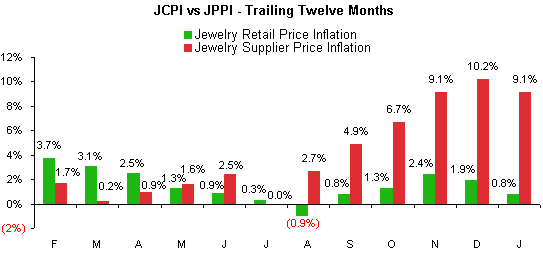IDEX Online Research: Jewelry Price Inflation Slows in January
March 02, 10
The flames of jewelry price inflation were doused somewhat in January, both at the retail and the supplier level. Two major factors had a dampening impact on jewelry price inflation: 1) lack of seasonal demand; and 2) stable commodity prices. In addition, currencies were relatively stable.
However, the margin squeeze between inflation at the supplier level and the retail merchant remains. While the overall rate of jewelry price inflation moderated in January, it is still running higher at the supplier and producer level than it is at the retail level. Thus, both jewelry retailers and jewelry producers are absorbing cost increases without the ability to pass them along to the next link in the chain of distribution.
January 2010 Jewelry Price Inflation Moderates
The key jewelry industry inflation statistics for January 2010 are as follows:
· Jewelry Producer Price Index (JPPI) = +9.1 percent
· Jewelry Consumer Price Index (JCPI) = +0.8 percent
The graph below compares the monthly JPPI to the monthly JCPI for the past twelve months.
|
|
Outlook: No Relief From Inflation
As the global economy heats up, there will be increasing demand for “hard assets” – specifically commodities including gold, platinum, silver, palladium, and diamonds – both from investors as well as end users in other industries. All of those commodities are major cost components of jewelry.
Until recently, jewelry producers were able to reduce – or stabilize – costs as they moved their factories to China and other countries with low-cost labor. However, not only are there virtually no developing countries left with lower labor costs, but labor costs in the Far East are rising. Thus, we expect to the see the labor cost component of jewelry begin to rise in 2010 and beyond.
In addition, prices for polished diamonds are rising, after remaining about flat for most of 2009. It is unlikely that jewelers will re-price diamond jewelry that they own in their inventory, but new incoming diamond merchandise will carry higher retail prices because of the increased cost of polished diamonds.
Retailers are faced with a major dilemma: consumers are seeking a value – better quality goods for a low price – but they also are seeking low price-point merchandise. The quality of merchandise at the “hot” $99 retail price point has deteriorated, and will continue to decline until it becomes junk jewelry. Somehow, consumers will need to be re-educated: you can’t have something for nothing. That’s the job of the industry: to explain the value of “luxury” to shoppers.
For more detailed analysis and statistics on jewelry industry inflation for January 2010, please click here.
